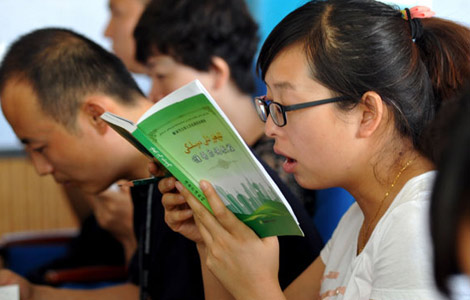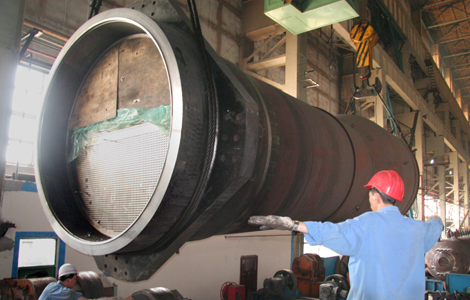Sino-US trade gap narrows
Updated: 2013-08-08 01:54
By ZHANG YUWEI (China Daily)
|
||||||||
United States exports to China, which have been growing in recent years, increased 4.5 percent in June, narrowing the trade deficit between the world's two largest economies, according to US Commerce Department figures released on Tuesday.
Exports to China — one of the fastest-growing markets for US goods — were up 4.2 percent for the first half, the new data show.
US exports to the European Union, however, only rose 1.5 percent in June, with first-half exports to the EU down 5.5 percent.
Guo Feng, a senior economist at the Institute of International Finance, said that US-China trade dynamics were affected by China's currency rate and increases in certain categories of US goods in June.
"The appreciation of the yuan versus its basket has been about 5 percent so far this year, making China's goods less competitive on the world market,"said Guo.
"The Chinese interbank cash crunch in June may have had some negative impact on exporters, and China increased imports from the US of goods such as machinery and agricultural products in June,"he added.
The yuan has appreciated by 1 percent against the dollar since the beginning of 2013.
Because of the weakening of some major currencies — including the yen and the British pound — the yuan's value has been pushed up in recent months, appreciating by nearly 20 percent against the yen since July.
The new US trade figures show imports from China fell 2.2 percent, lowering the contentious US trade deficit with China to $26.6 billion from $27.9 billion in May.
"China has been a fast-growing export destination for US companies and the underlying trend for US exports to China has been upward since mid-2009,"said Sophii Weng, an economist with Standard Chartered Bank in New York.
China remained the US' third-largest export market after Canada and Mexico, purchasing nearly $110 billion in US goods in 2012, according to the Washington-based US-China Business Council, which represents more than 200 US companies doing business in China.
The council's new report on US exports to China by congressional district — released last week — showed that between 2003 and 2012, total US exports to China rose 294 percent.
In 2012, the report said, 262 congressional districts (60 percent of the total) increased exports to China. Between 2003 and 2012, 401 congressional districts (92 percent) experienced triple-digit growth.
Growth in exports to China also outpaced growth in the majority of districts' exports to other markets, with 249 districts out of 435 having higher growth in exports to China in 2012 than to the rest of the world.
Even smaller states have seen significant growth in exports to China. Shipments from Vermont, Connecticut, Hawaii and Delaware have recorded at least 400 percent growth since 2003.
"Integrated bilateral trade between the US and China, thanks to the globalization of supply chains, has made China a top export destination for US manufacturers, supporting a broad range of US producers regarding industrial supplies and capital goods,"said Weng.
Stronger US economic growth will lead to solid US imports from China, said Weng, adding that the US has outperformed other major developed countries since 2009.
"We expect US economic growth to accelerate in the second half of this year, assuming fiscal headwinds dissipate gradually, in which case China's exporters would benefit,"said Weng.
The Commerce Department figures show the US trade deficit narrowed sharply in June to its lowest level in nearly four years, indicating a stronger outlook for second-quarter growth.
Guo said net exports looked much more favorable for growth in the second quarter than the advance GDP of 1.7 percent estimated by the US Bureau of Economic Analysis last week.
The trade gap fell 22.4 percent to $34.2 billion, the smallest since October 2009. The percentage decline was the largest since February 2009.
The strong trade figures showed the US economy is getting back on track from the 2008 financial crisis. A stronger economic outlook in the US is also pushing forward the US Federal Reserve's plan of tapering off the $85-billion-a-month bond-purchase program, known as quantitative easing.
Weng said the tapering of the QE3 program will mostly be based on US unemployment figures rather than GDP.
"The job figure (162,000) in July wasn't too bad, but we still need to see what August looks like,"she said.
- Latest US-China talks should smooth the way
- Innovation key to new US-China relations
- Renewed emphasis on US-China investment treaty 'positive'
- Furthering China-US trade
- Bumpy ride for Sino-US trade
- Keys to avoiding a China-US trade war
- China still lags US in trade
- Statistical discrepancy declines in Sino-US trade
Most Viewed
Editor's Picks

|

|

|

|

|

|
Today's Top News
China to be leading business travel market
Cards make paying global tuition easier
Probes not targeting foreign brands
Sino-US trade gap narrows
Dairy firms hit with fines
A stage set for big innovation
Exports, spending 'to ebb'
Islands dispute hammers attitudes
US Weekly

|

|












